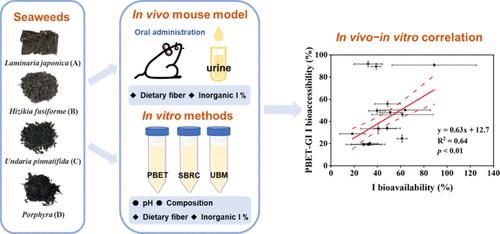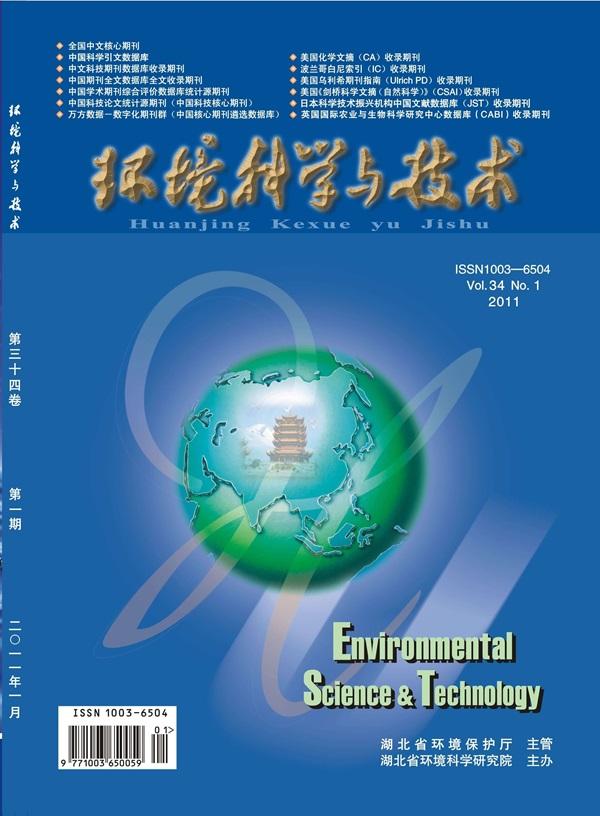食用海藻中碘的体内生物利用度和体外生物可及性:方法发展和健康意义
IF 10.8
1区 环境科学与生态学
Q1 ENGINEERING, ENVIRONMENTAL
引用次数: 0
摘要
碘(I)缺乏和碘(I)过量都会对人体健康产生不利影响。海藻是维生素I最重要的天然来源之一。本研究采用小鼠体内模型评估了维生素I的相对生物利用度(RBA),并将其与三种体外方法(生理提取试验(PBET)、溶解度生物可及性研究联盟(SBRC)和欧洲方法统一生物可及性研究小组(UBM))测定的维生素I的生物可及性进行了比较。来自4个品种的26份海藻样品的总I浓度在52.4至1322 mg/kg干重之间。I RBA变化范围为18.5% ~ 89.0%,受无机I百分比的显著影响(r = 0.50, p <;0.01)和总膳食纤维含量(r = - 0.28, p <;0.05)。不同种类、不同提取方法的海藻I的生物可及性不同,且受胃液pH值和海藻体外提取过程中结构变化的影响。相关分析显示PBET是I RBA的最佳预测因子(R2 = 0.64)。这些结果为预测海藻中I的生物利用度提供了一种合适的体外方法,为准确评估I的膳食摄入量提供了有益的依据。本文章由计算机程序翻译,如有差异,请以英文原文为准。

In Vivo Bioavailability and In Vitro Bioaccessibility of Iodine in Edible Seaweeds: Method Development and Health Implications
Both iodine (I) deficiency and I excess can adversely affect human health. Seaweed consumption is one of the most important natural sources for I. This study assessed I relative bioavailability (RBA) in seaweed using an in vivo mouse model and compared it with I bioaccessibility measured by three in vitro methods (Physiologically Based Extraction Test (PBET), the Solubility Bioaccessibility Research Consortium (SBRC), and the Unified Bioaccessibility Research Group of Europe Method (UBM)). Total I concentrations in 26 seaweed samples from four species ranged from 52.4 to 1322 mg/kg of dry weight. The I RBA varied from 18.5% to 89.0%, significantly influenced by inorganic I percentage (r = 0.50, p < 0.01) and total dietary fiber contents (r = −0.28, p < 0.05) in seaweeds. The I bioaccessibility varied among species and methods and were affected by the pH of gastric solution, as well as the structural changes in seaweed during in vitro extraction. Correlation analysis demonstrated that PBET was the best predictor for I RBA (R2 = 0.64). These results developed an appropriate in vitro method for predicting I bioavailability in seaweeds, which is highly beneficial for the accurate assessment for I dietary intake.
求助全文
通过发布文献求助,成功后即可免费获取论文全文。
去求助
来源期刊

环境科学与技术
环境科学-工程:环境
CiteScore
17.50
自引率
9.60%
发文量
12359
审稿时长
2.8 months
期刊介绍:
Environmental Science & Technology (ES&T) is a co-sponsored academic and technical magazine by the Hubei Provincial Environmental Protection Bureau and the Hubei Provincial Academy of Environmental Sciences.
Environmental Science & Technology (ES&T) holds the status of Chinese core journals, scientific papers source journals of China, Chinese Science Citation Database source journals, and Chinese Academic Journal Comprehensive Evaluation Database source journals. This publication focuses on the academic field of environmental protection, featuring articles related to environmental protection and technical advancements.
 求助内容:
求助内容: 应助结果提醒方式:
应助结果提醒方式:


